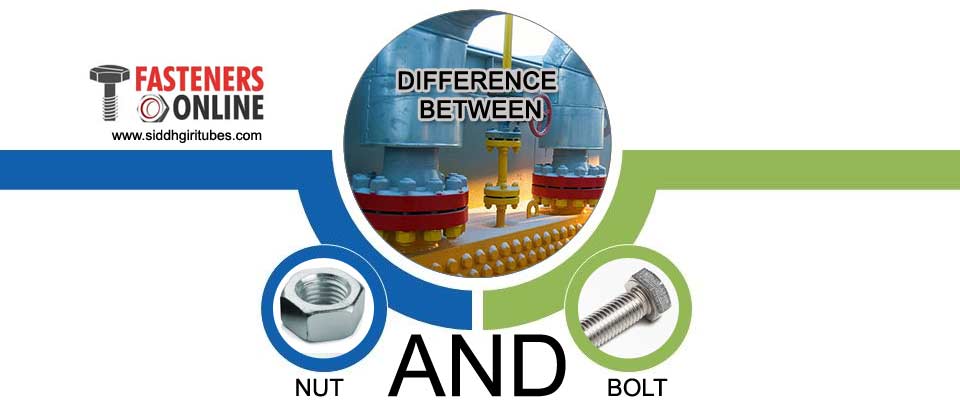Difference Between Nut and Bolt

Spiral carved grooves wrap around the centre of the nut, making it possible to hold it securely in one's hand while still allowing for easy removal. The thread is the technical term for the spiral groove.
However, bolts are metal pieces with spherical stems and threaded ends, having a head on one end for a secure grip. An important element of a threaded connection is bolted together with the use of bolts. Certain bolts are threaded all the way through, while others are simply threaded at the end. Bolts occur in a variety of lengths and diameters, while nuts are only available in a single size. The thickness of the material between both the bolt's head as well as the nut determines the kind of bolt to use. Nuts and bolts, on the other hand, maybe made from any metal.
Hot-dip galvanized nuts bolts vs hot forged fasteners
Hot-dip galvanized nuts bolts
Steps in the hot-dip galvanising process may be divided into three general categories: surface preparation, galvanising and inspection. This is the most important step since zinc only adheres to steel that is clean and pure. Zinc coatings will not adhere to fasteners that are covered with dirt, grease, or other impurities. The steel fasteners are immersed in a succession of chemical baths to prepare the surface for galvanising.
Hot Forged Fasteners
There are two ways to create hot forged fasteners: one uses heat to weaken the metal as well as make it simpler to form; the other uses cold forging. Originally, heated metals were hammered into the form using a hammer to produce fasteners, such as bolts. The forge has indeed been replaced with an induction heater, and the hammer is now mechanical.
Hex bolt vs Allen bolt
An L-shaped hexagonal tool intended to fit as well as drive nuts and screws with a hexagonal socket in its heads is known as a "hex wrench" or "Allen wrench."
This kind of fastener is less prone to wear and damage than a normal six-sided nut or bolt because of the recessed area of its hexagonal socket.
Threaded rod tensile strength, tensile capacity and Grades
The ability to withstand tensile stress.
For every given project, the material utilised to produce a threaded rod will have an impact on the tensile strength of the product. Metal grades 8 and B7, for example, may be used in certain applications, whereas low-carbon metals can be used in many others.
The maximum amount of tensile stress is the greatest load it can bear before breaking.
You may imagine it as a rubber band getting stretched all the way to its limit and then cracking. A threaded rod's tensile strength is the maximum number of tensile stress it can sustain before breaking. Tensile stress may cause the threaded rod to shatter, like a rubber band that has been stretched beyond its limit of strength.
If a material's yield strength ranges from 85% to 95%, it is utilised for non-destructive testing. There must be no indication of persistent deformation in order for a specimen to meet this requirement.
Mechanical tests are used in the threaded rod business to measure tensile strength, ultimate tensile, and some other mechanical parameters. These tests are carried out in a controlled environment and use a certain amount of force to measure a material's tensile strength.
What is socket head cap screw din 912?
Removable panels and sections may be assembled using socket head cap screws. In order to tighten them, you must use a socket wrench to turn the round cap with a hex head. To avoid snagging clothes or links when secured, button and flat-head hats are preferable. Cap screws with such a black oxide or armour coat finish are more resistant to rusting.
Flange bolt application
Using flange bolts will guarantee a long-lasting link between different pieces of an enclosed space. As a case study, think about the relationship between a vehicle's gearbox and engine. Moving components in the engine and the gearbox may be harmed if tiny items, dirt, or dust enter them. To keep the engine and gearbox safe, the flange bolt is used to fasten the exterior casing.
Stud bolt vs machine bolt
Stud bolts are those that have no head and can only be fastened with vice grips or nuts, and they are the most common kind of fastener. With a wrench, you can tighten machine bolts.
Head types of bolts and screws
Bolt and screw heads come in a variety of shapes and sizes.
- Large, low, and high on the outside edge are the characteristics of pan heads. Slotted or flat drivers can readily grasp and put force on the head because of the wide surface area.
- The predecessor to the pan head is the round head.
- Fillister Head - The tiny diameter of Fillister heads means that they exert greater pressure on surfaces.
- Another model that has been largely replaced by pan heads is the binding head.
- Low, rounded, and exceptionally broad are the truss head's characteristics.
- As the name implies, the one-way head may only be placed in a single direction.
- Products with smooth surfaces or short lengths might benefit from flat and oval heads.
- Hexagon-Indented Square Shoulder Screws
- The tensile properties of hex cap screws may be increased by adding a shoulder (an unthreaded space behind the head) to the bolt. Due to their restricted threaded lengths, these screws really aren't ideal for many applications.
- However, Tap Bolts are completely threaded irrespective of their diameter. As a result, the threading extends from the tip of something like the bolt all the way down to the bolt's head.
Which coating is suitable for marine fasteners?
Known as HD, this coating is put on steel in order to protect it against rust. Zinc coats the hot-dip galvanised fasteners. This kind of fastener is often used in environmental applications where they'll be exposed to adverse weather conditions, such as rain or snow, such as in the construction industry. Also appropriate for coastal locations where the salt content is greater, the HD fasteners are excellent.
Self-drilling screw vs self-tapping screw
A pilot hole isn't necessary for self-drilling screws since the drill bit end is on the other end. Designed for this purpose, they are excellent at securing thin metal components together.
It is necessary to drill a pilot hole somewhat smaller than the diameter of the self-tapping screw.
Allen screws manufacturing process
When there's not enough room for a wrench or a socket, socket head cap screws are appropriate.
In order to tighten them, you must use a socket wrench to turn the round cap with a hex head. To avoid snagging clothes or links when secured, button and flat-head hats are preferable.
Hot-dipped galvanized bolts vs stainless steel bolts
Which one of these two kinds of fasteners is better? With the end, galvanised screws are nothing more than black steel coated in zinc. However, it is possible to wear away zinc's protective layer, allowing the original steel to be exposed to the environment. Once exposed to the elements, black steel may soon corrode.
Stainless steel, on the other hand, does not need the use of a protective coating. Chromium is a substantial component of this alloy. Steel's endurance and resistance to corrosion are both enhanced by the presence of this strong metallic element. The most crucial thing to keep in mind is that stainless steel is known as such because of its chemical makeup, which is completely stainless. Fasteners constructed of this material are stainless throughout, from the thread to the core, the head to the tip. In contrast, the rust resistance of galvanised fasteners is provided by the zinc coating on the fasteners. This discrepancy is the primary consideration in making your final decision, but it is not the only one.
Impression Die Forging
Compressive pressures are used in forging to mould billet metal into much more complicated shapes, as you may be aware. To form a metal billet that has been heated to the right temperature, an impression die forger uses two or more dies. Forging may need a single set of dies or many sets of dies, depending on the design of the component.
A component may go through bursting, blocking, and finishing dies using multistage forging. Finishing dies fine-tune geometric characteristics without materially altering the item's shape or increasing material flow during the first two processes.
Cold forging
While still below its recrystallization point, metal is deformed during cold forging. When working with aluminium, which is a soft metal by nature, cold forging is the method of choice. This method is less costly than hot forging, and the final product needs little to no finishing work unless otherwise specified by the manufacturer. For added strength, aluminium that has been cold forged into a particular form may be heat treated. "Tempering" is the technical term for this procedure.
Cold forging, despite its name, takes place at or near room temperature, despite the term "cold." When it comes to cold forging, normal and carbon alloy steels are the most often used metals.
Open Die Forging
Smith forging and free forging are other names for open die forging. Often, the tolerances necessary for the final standards are not achieved by the open die forging process alone. Simple, short-run items, such discs, rings, sleeves, cylinders and shafts, are common candidates for Smith forging. With free forging, custom forms may be made.
The strength of something like the grain structure is increased by repeatedly putting the material through into the deformation process. Other benefits of open die forging include enhanced fatigue resistance, increased strength, and fewer voids in the finished product.
Seamless Rolled Ring Forging
Forging metal by punching a hole in a large, solid, circular piece of metal to form a doughnut shape and then compressing and pressuring the doughnut shape into a thin ring is known as "rolled ring forging."
Roll ring forging requires that the workpiece's centre be cut out. Punching is one of the many terms used to describe this portion of the procedure. A doughnut-shaped piercing is the outcome of piercing. When a piercing is used, a punch is used to penetrate the workpiece, creating an aperture in its centre and leaving a thin web of metal at the bottom of the perforated opening.
Difference between rivets and studs
A metal rod or shaft with threads on both sides is known as a stud. Generally speaking, studs are long; however this might vary based on the intended use and application of the stud in question. As opposed to screws or bolt heads that may be rotated to tighten them, studs do not have a "head."
With an unthreaded, planar shaft, the rivet is used to attach two or more pieces together mechanically. The rivet cannot be removed from the hole because of the firmly formed heads on both ends. Components cannot move radially due to the shaft.
Blog
Industrial Products
Types
LOOKING FOR TRUSTED AND RELIABLE MANUFACTURER OF FASTENERS
Buy in Bulk & Save on All Orders
Contact Us Today With Our Online Form
